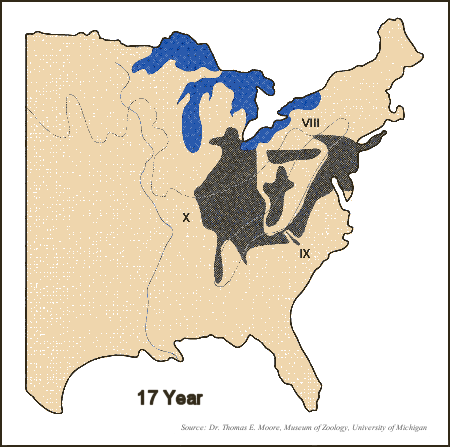 Featuring eXtreme croquet and eXtreme croquet mallets.
Featuring eXtreme croquet and eXtreme croquet mallets.

 Dedicated to enjoying eXtreme croquet, nature, and the near-death experience!™
Dedicated to enjoying eXtreme croquet, nature, and the near-death experience!™






















Legal

|
 |


Return of the Seventeen Year Locust  These bugs can overwhelm your game if you're not prepared.
These bugs can overwhelm your game if you're not prepared.
Did you ever wonder what insects make that loud buzzing sound in the trees during the daytime in summer? Well, it's a widely heard but rarely seen kind of insect called a cicada (si-Kay-da). The ones you hear every summer are non-periodical, which means some appear every year despite the fact that they take several years to develop into adults. These are green in color and about the size of an almond with the shell on.
The cicadas appearing as adults in the next few years - the ones that can overwhelm you and your eXtreme game - emerge in 17 year intervals in large and generally non-overlapping geographic regions of the northeastern United States. These insects are about the size of your little finger, measuring about 0.5 inches wide and 1.5 inches long. black in color, have reddish eyes and reddish veins in their wings. They are commonly called the 17 year locust (at least in Connecticut, anyway).
Because of this separation in time and place, they are called periodic cicadas. They are expected to appear in 16 states in 2004. Another brood should appear in four states in 2007, and yet another in 12 states in 2008.
Periodic Cicadas Brood X
2004 State Distribution Map

Cicada Brood X is expected to appear in 16 states in 2004
When these periodic cicadas emerge,their population density is enormous, and can exceed 1 million per square acre (several hundred thousand is usual). There can be so many empty shells on the trees where they emerge, that you can't see the tree bark, only the massive covering of shells. If you play eXtreme in a brood infested area, your ears can be vulnerable. Only the males sing, but the simultaneous buzzing from a hundred thousand or so of these "locusts" is absolutely shattering and nerve wracking. If you don't wear ear plugs, you may as well just stay home.
Three species usually emerge mixed together in the same area. Their songs are quite different, and they vary in average size. They are expected to emerge from the soil in early May and June, and are active as adults for 30 - 50 days. They live by sucking sap from trees. They do not bite or chew leaves or people. It's actually kind of fun to pick them up. When you do, they get scared and start to buzz. It will startle you because it feels like an electric shock to your fingers.
After they mate, the females lay hundreds of eggs, and then both the males and females die. They leave massive numbers of carcasses everywhere. It can get pretty ugly if you try to play through the freshly dead carcasses. Extreme or not, it's still pretty ugly.
After about 9 weeks, the baby cicadas hatch, and burrow into the ground. They live underground by sucking sap from the plant roots. They remain there for 17 years, waiting to start the cycle all over again. It's only then, that your game can return to "normal".
 Used with Permission Used with Permission
Adapted from the article "Periodic Cicadas Will Emerge In 16 States In 2004"
written by Randy Simmons, Vice President, Air Solution Company.
Original article Copyright © by Randy Simmons, All rights reserved.
Home |
Intro |
Playing |
Rules |
Gallery |
Articles |
Mallets |
News |
Contact |
Links
Copyright © 2000 - 2020 by
Connecticut eXtreme Croquet Society
All rights reserved
|

|
|
|

